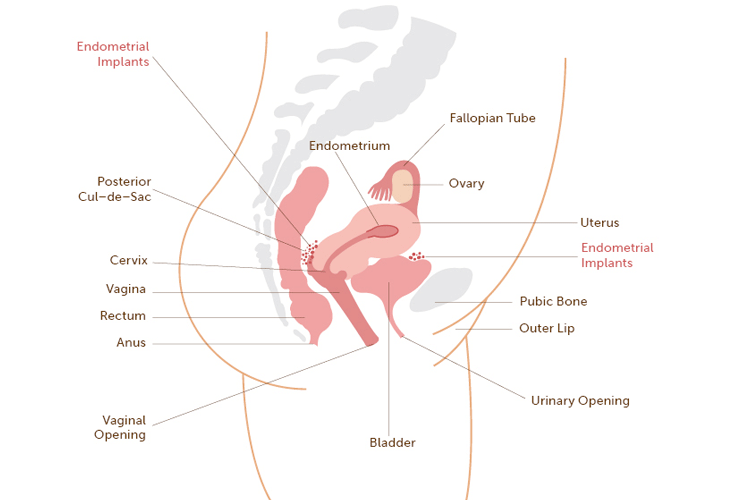 The best thing you can do to understand your daughter’s diagnosis is to learn all you can about endometriosis. It’s helpful for both you and your daughter to maintain an ongoing list of questions for your daughter’s GYN team. The doctors, nurses, and social workers will assist you and your daughter in understanding her diagnosis and the treatment options at all stages of her treatment.
The best thing you can do to understand your daughter’s diagnosis is to learn all you can about endometriosis. It’s helpful for both you and your daughter to maintain an ongoing list of questions for your daughter’s GYN team. The doctors, nurses, and social workers will assist you and your daughter in understanding her diagnosis and the treatment options at all stages of her treatment.
What is endometriosis?
Endometriosis, pronounced, “end–o–me–tree–o–sis” can affect girls of all ages.It is a condition that occurs when tissue similar to the inside lining of the uterus is found outside of its normal location. Endometrial implants can be found on the ovaries, fallopian tubes, and ligaments that support the uterus and tissue covering the bladder and rectum. The most common locations of endometrial implants in teens are in the cul–de–sac area (behind the uterus), and near the bladder.
What are the symptoms of endometriosis?
Endometriosis causes different symptoms in young women. Pelvic pain and/or severe period cramps are the most common symptoms. There can be pain before, during or after a period. The pain may occur at regular times in the menstrual cycle or it may occur at any time during the month. It is often referred to as “chronic” pelvic pain.
The location of the endometrial implants and the way in which the lesions affect the pelvic organs contribute to the symptoms girls may have. Some girls may have pain with exercise, sex, and/or after a pelvic exam, others do not. Although not as common, some girls may have painful or frequent urination, diarrhea or constipation with pelvic pain. It’s important to remember that some girls have a lot of endometriosis and have very little pain, while others may have a small amount of endometriosis and severe pain.
What causes endometriosis?
Although we know that some young women may be slightly more likely to develop endometriosis because female relatives have it, the fact is we do not know the cause of this disease.
The three most accepted theories are:
- Sampson’s Theory: This theory explains that the flow of menstrual blood gets “backed up” causing some of the blood to flow in a reverse direction. This process causes blood containing endometrial tissue to attach to surfaces outside of the uterus.
- Meyer’s Theory: This theory proposes that specific cells called “metaplastic cells” change into endometrial cells and are actually present at birth.
- Vascular Theory: This theory suggests that the endometrial tissue “travels” through the body via blood vessels. It then reaches various tissues, implants, and then grows, causing pain.
Important facts about endometriosis:
- Young women CAN suffer from symptoms of endometriosis. Medical studies have found this disease in teenagers and young children.
- Chronic pelvic pain is NOT normal. Most young women have no or mild to moderate menstrual cramps one or two days a month. If your daughter is absent from school because of pelvic pain or menstrual cramps, tell her GYN team.
- Endometriosis occurs among women of ALL races.
- Endometriosis is NOT an STI (sexually transmitted infection).
- Getting pregnant does NOT cure this disease but may improve symptoms for some women. Some women with endometriosis who have had children continue to have pain.
- If your daughter’s pain makes her feel at all disadvantaged compared to other young women or young men her age, this is NOT normal. Your daughter should not “normalize” her symptoms. If your daughter doesn’t feel like she’s as equally capable as other teens her age (because of pelvic pain), she should tell her gynecologist.
Our health guides are developed through a systematic, rigorous process to ensure accuracy, reliability, and trustworthiness. Written and reviewed by experienced healthcare clinicians from Boston Children's Hospital, a Harvard Medical School teaching hospital and consistently ranked as a top hospital by Newsweek and U.S. News & World Report, these guides combine clinical expertise, specialized knowledge, and evidence-based medicine. We also incorporate research and best practices from authoritative sources such as the CDC, NIH, PubMed, top medical journals, and UpToDate.com. Clinical specialists and subject matter experts review and edit each guide, reinforcing our commitment to high-quality, factual, scientifically accurate health information for young people.
